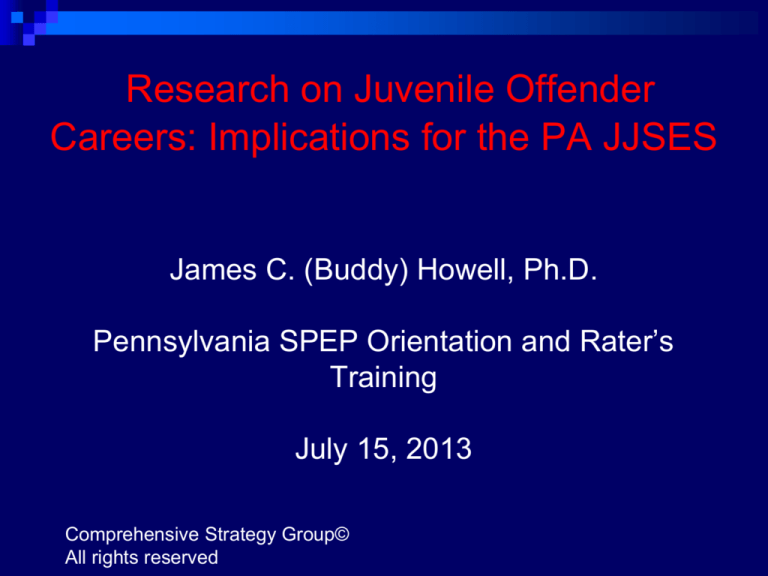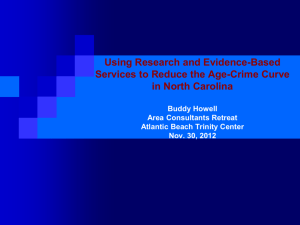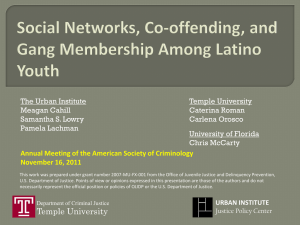
Research on Juvenile Offender
Careers: Implications for the PA JJSES
James C. (Buddy) Howell, Ph.D.
Pennsylvania SPEP Orientation and Rater’s
Training
July 15, 2013
Comprehensive Strategy Group©
All rights reserved
Goal: Bend the age-crime curve in PA
Source: Justine Fowler, PA Juvenile Court Judges’ Commission
First Study of Entire Juvenile Offender
Court Careers From Age 10 to 18 (Arizona )
Chronic
Serious
15%
34%
C,S & V
Violent
8%
4%
64%
Non-Serious
Non-Violent
Non-Chronic
Source: Snyder (1998) Maricopa Co. Study (N=151,209)
Developmental Pathways to Serious and Violent Behavior
AGE OF ONSET:
LATE
%BOYS/GIRLS:
FEW
VIOLENCE SERIOUS
(rape, attack,
strong-arm,
homicide)
PHYSICAL FIGHTING
(physical fighting,
gang fighting)
DELINQUENCY
(auto theft,
burglary)
MODERATELY
SERIOUS
DELINQUENCY
(fraud, pick-pocketing)
AUTHORITY
AVOIDANCE
MINOR AGGRESSION
(bullying, annoying others)
OVERT PATHWAY
PROPERTY DAMAGE
(vandalism, fire-setting)
(truancy,
running away,
staying out late)
Defiance/Disobedience
MINOR COVERT BEHAVIOR
(shoplifting, frequent lying)
COVERT PATHWAY
(before age 15)
Stubborn Behavior
EARLY
AUTHORITY CONFLICT PATHWAY
© R. Loeber: Pittsburgh Youth Study (before age 12)
MANY
A larger percentage of very young offenders
have serious, violent, and chronic careers
Source: Snyder (1998) Maricopa Co. Study
A small proportion of delinquents is
responsible for half of all youth crime
Source: Loeber, Slot, Laan, & Hoeve, 2008
Timing of Delinquency and
First Felony Court Contact
Age:
Minor
Problem
Behavior
Moderately
Serious
Problem Behavior
Serious
Problem
Behavior
7.0
9.5
11.9
14.5
First Court
Contact for an
Index Offense
Source: Loeber: Pittsburgh Youth Study
Comprehensive Strategy for Serious,
Violent, and Chronic Juvenile Offenders
Problem Behavior > Noncriminal Misbehavior > Delinquency > Serious, Violent, and Chronic Offending
Prevention
Target Population: At-Risk Youth
Programs for
All Youth
>
Programs for Youth at
Greatest Risk
Immediate
> Intervention >
Preventing youth from becoming
delinquent by focusing prevention
programs on at-risk youth
Intervention & Graduated Sanctions
Target Population: Delinquent Youth
Intermediate
Sanctions
Community
> Confinement >
Training
Schools
>
Improving the juvenile justice
system response to delinquent
offenders within a continuum of
treatment options and system of
graduated sanctions
Source: Wilson & Howell (1993)
Aftercare
Strongest Risk Factors for Later
Delinquent or Criminal Offending
The single strongest risk factor : Prior
delinquent or criminal behavior
Early problem behavior: School failure, violent,
aggressive, & impulsive during childhood
Family risk factors measured during childhood
Other key risk factors within the individual,
family, peer, and school risk domains vary in
strength across the developmental stages in
adolescence and early adulthood.
Source: Tanner-Smith, Wilson, & Lipsey, in press
Two Poorly Served Offender Groups
that Impede Successful Bending of the
Age-Crime Curve
Girls
Gang Members
Why are girls important?
Potential serious, violent, chronic
offenders
Do delinquent boys and girls have the
same risk and protective factors? Yes.
But the cumulative effects of risk factors
may be worse for girls than for boys;
requiring multimodal services.
And girls also have higher levels of cooccurring problems than boys.
Girls Unique Treatment Needs
Delinquent girls are more impaired across a
range of co-occurring domains; and uniquely,
anxiety and affective disorders..
Delinquent girls have more severe family
problems, especially in disadvantaged areas.
Although boys are more likely to report some
type of assault victimization, females are 10
times more likely to experience sexual assault
than boys.
Sources: Augimeri et al., 2013, Hipwell & Loeber, 2006, Wasserman
et al., 2005
Juvenile Self-reported Violence Rates
Before, During, and After Gang Membership
Mean Number
Pittsburgh, Seattle, Denver, Rochester
8
4
Before
Source: Howell, 2012
4
During
After
Levels of Gang Involvement
Level
Level
Level
Level
Level
Source: Johnson, 1987
I—Fantasy
II—At-risk
III—Associate
IV—Active Gang Member
V—Core Member of Gang
Comprehensive Gang Prevention,
Intervention, and Suppression Model
National Gang Center: http://www.nationalgangcenter.gov/
Key Statewide Delinquency
Intervention Strategies for Bending the
Age-Crime Curve
Forestall progression to serious, violent,
and chronic (SVC) offender careers
Intervene early with potential SVCs
Serve girls intensively as well as boys
Target gang members
Promote desistance
A goal within reach: Bend the agecrime curve in Pennsylvania with
JJSES tools and the SPEP









